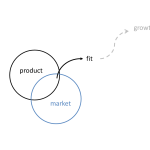Nuts and bolts #2: 9 delightful things about product-market fit
- By ssyc1
- September 24, 2018
- No Comments
 A lot of ink has been spilled on “product market fit” but we are still very often answering Qs about this and so we are going to jot down a few things about this. Because a major part of getting ready to scale up is about getting product market fit (“PMF”) and we can’t think of anything more important (not achieving PMF is probably a number 1 reason for start-up failure), here are 9 things about PMF that we – students of startup successes and failures – have learned along the way:
A lot of ink has been spilled on “product market fit” but we are still very often answering Qs about this and so we are going to jot down a few things about this. Because a major part of getting ready to scale up is about getting product market fit (“PMF”) and we can’t think of anything more important (not achieving PMF is probably a number 1 reason for start-up failure), here are 9 things about PMF that we – students of startup successes and failures – have learned along the way:
- First up, a great product that does not find market fit does not make a great company or impact.
- Following from that, do whatever you can to get there. Startups who successfully navigate scale-up often find their product-market fit only after a series of iterations and failures; it may require changing out people, rewriting your product, moving into a different market, telling customers no when you don’t want to, telling customers yes when you don’t want to, raising that round of highly dilutive venture capital – whatever is required.
- Following also from point #1, and as a general rule, don’t just focus on product, focus on product-market fit first, then go back to product v.2.
- The process of finding PMF fit is an art rather than a science: through a series of build-measure-learn iterations, PMF is discovered and developed during a process that is essentially a “discovery process”.
- You can always feel PMF when it’s happening: there is much word of mouth, customers are buying the product as fast as you can make it or usage is growing just as fast as you can add more servers, you’ve got to hire sales as fast as you can, and you are essentially confronted with your first series of “growth pains”. A helpful quote from guru of the lean startup movement, Eric Ries: “The term product/market fit describes ‘the moment when a startup finally finds a widespread set of customers that resonate with its product’.” (On our list of questions asking about founders’ “scale up readiness”, we ask “”can you describe your customer profile(s)” and “how do you attract your customers”?)
- Metrics can mislead; a quote from the venture investor who coined the term “product-market fit”, Andy Rachleff, makes this clear: “You know you have fit if your product grows exponentially with no marketing. That is only possible if you have huge word of mouth. Word of mouth is only possible if you have delighted your customer.” Tying together the concepts, Rachleff also shares that entrepreneurs too often confuse product/market fit with growth in “vanity metrics” (“numbers or stats that look good on paper, but don’t really mean anything important”).
- A great market can “pull” an average product and create much growth as the customers’ “pain” cause them to reach out for it. (All the more reason for point #3 above).
- PMF is not a magic potion, it is only an important milestone that is a necessary but not sufficient condition for success. Once a company has PMF it still must find a sustainable growth model and create a moat against competitors and so on. What PMF does do is help prevent businesses from spending money trying to grow a business in a way that is doomed to fail – this is probably one of the biggest reason we see when startups fail to survive. Go back to point #2 above.
- The positive thing about a great market is that it can make an average startup look like it is a great startup (e.g. makes it easier to hire great people and upgrade the team); the negative is that it makes it feel like it is a great startup (e.g. when the market growth inevitably returns to “normal” levels, the average product may be “shown up” and especially if the founders or the management team get afflicted with arrogance problems).






Leave a Reply